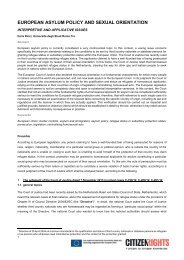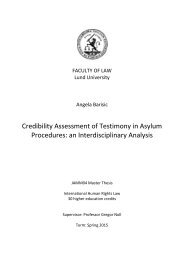AEMI
AEMI-2016-web
AEMI-2016-web
Create successful ePaper yourself
Turn your PDF publications into a flip-book with our unique Google optimized e-Paper software.
SARAH MARIJNEN AND JEROEN DOOMERNIK<br />
ceptance of ICA overlooks the negative<br />
impact on birth mothers. They argue<br />
that in some underdeveloped countries<br />
illegal baby trade is seen as a solution<br />
to the problem of inadequate prenatal<br />
services and care. In this view, women<br />
are considered as ‘breeders’, who produce<br />
healthy babies for the ICA market<br />
(Ibid.: 48). The responsibility of<br />
the governments of sending states to<br />
provide for family planning services and<br />
improve the position of (teenage) mothers<br />
is avoided by participating in the<br />
ICA market.<br />
Therefore, as Schaepmaker et al.<br />
(2008) argues, ICA often comes down<br />
to exploitation of vulnerable families<br />
who have no other choice. Parents are<br />
often persuaded by tricks to give their<br />
children away, without understanding<br />
exactly what adoption means and assuming<br />
that their children will come<br />
back (Ibid.: 33). Anthropologist Shellee<br />
Colen (1995) believes that adoption is<br />
a product of ‘stratified reproduction’,<br />
which refers to reproductive labor by<br />
women structured by political, economic<br />
and cultural forces and results<br />
in unequal hierarchies of race, class,<br />
place and gender in the global economy.<br />
Known from the trafficking of children<br />
for sexual exploitation are cases in which<br />
parents see themselves forced to sell one<br />
or more children in order to be able to<br />
support the remaining household members<br />
(Doomernik, 2006) and doing so<br />
for adoption would appear a humane<br />
option in comparison.<br />
To conclude, the consequences of a<br />
demand-driven market for adoptees are<br />
painful because not only the interest of<br />
the costumers in the market are put first,<br />
the adoptees are being commodified and<br />
147<br />
therefore it is questionable whether their<br />
adoption cases were processed in a fair<br />
and legal manner. The prospective parents<br />
are responsible for the high demand<br />
but at the same time are not aware of<br />
the negative impact on the ICA market,<br />
because they are easily fooled into<br />
putting their trust in adoption agencies<br />
who again may be tricked into accepting<br />
orphans who actually are not.<br />
Conclusions<br />
When migration takes on market features,<br />
we can differentiate, like Salt &<br />
Stein (1997) have done before us, between<br />
legal and illegal sides of the business.<br />
Among the legal aspects of ICA<br />
we can list instances where a child is<br />
truly an orphan, cannot domestically be<br />
matched with suitable adoptive parents<br />
and therefore migrates to another country<br />
thus serving its best interests. On the<br />
other end of the spectrum we find deceptive<br />
practices and children being sold<br />
and bought in order to satisfy the needs<br />
of prospective adoptive parents abroad.<br />
In between these two positions we find<br />
a grey area in which both worlds seem<br />
to meet and in which it seems often unclear<br />
whose interests are served in what<br />
particular manner. It also has become<br />
clear that attempts to bring and keep the<br />
market in international adoption above<br />
board by means of (international) legal<br />
interventions are not easy. This appears<br />
not least to be so while policies at the<br />
receiving end (the countries of adoptive<br />
parents) aim to serve different needs<br />
that are at odds to each other, at least to<br />
some extent. Adoption should not fall<br />
under the restrictive regimes that as a<br />
rule govern migration from developing<br />
nations while it fulfills affective needs









